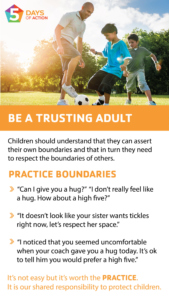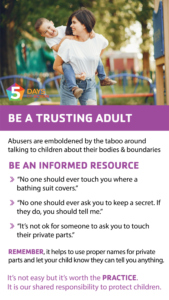5 DAYS OF ACTION
At the Y, child protection is our number one priority year-round. During April – Child Abuse Prevention Month – we participate in a week-long campaign, "Five Days of Action", to increase awareness of child sexual abuse and empower and equip our communities to prevent it.
During this week we will be sending out helpful resources, tips, and sharing what WE do at the YMCA to keep the kids in our community safe! We encourage all individuals to view our resources below on how to KNOW, SEE, and RESPOND to child abuse, how to be a "safe adult" for kids, and tips that parents can utilize.
KNOW, SEE, RESPOND
Knowing about child sexual abuse can help us better understand what to look for and how to keep it from happening in the first place. As parents, caregivers, and trusted adults to the young people in our lives, we play an important role in protecting them from abuse. This requires our commitment to continually learn and then ask questions about the safety of our loved ones.
The Y—and other youth serving organizations—implement a series of measures to keep the kids in their care safe. Next time you enroll your loved one in a new program, ask them about their child protection practices. For this summer, you can use this list.
KNOW, SEE, RESPOND
When we SEE boundaries being crossed or suspect a child is being abused, we can and should act quickly.
Learn these different child abuse definitions and indicators provided by Nebraska's Health and Human Services to help you identify possible forms of abuse you may see.
PHYSICAL ABUSE
Definition: Non-accidental infliction of injury or an act that poses substantial likelihood of bodily injury. Such injury is considered abuse regardless of whether the caregiver intended to hurt the child. Physical discipline, such as spanking, is not considered abuse as long as it is reasonable and causes no bodily injury to the child.
Indicators:
-
Unexplained injuries.
- Bruises or other marks.
- Arrives early to school and stays late.
- Parent tells teachers to use harsh physical discipline if child misbehaves.
- Parent Offers conflicting, unconvincing, or no explanation for the child's injury, or provides an explanation that is not consistent with the injury.
- Unexplained burns, bites, bruises, broken bones, or black eyes.
- Has fading bruises or other marks noticeable after an absence from school
- Child shrinks at the approach of adults, or is generally afraid of adults.
- Child is reluctant to be around a particular person or seems frightened.
- Child Discloses abuse.
- Parent Offers conflicting, unconvincing, or no explanation for the child's injury, or provides an explanation that is not consistent with the injury.
UNREASONABLE USE OF CONFINEMENT
Definition: Any type of activity the caregiver uses to confine or restrict the child such as tying the child up with rope, duct tape, or chain to keep the child in one place.
Indicators:
-
Changes in behavior or school performance.
- Learning problems or difficulty concentrating.
- Overly compliant, passive, withdrawn
- Unexplained bruises;
- Is reluctant to be around a particular person or seems frightened.
CRUEL PUNISHMENT
Definition: Any type of discipline that results in injury, cuts, bruising, withholding food, water, required care, or requiring a child to consume nonfood items or inappropriate amounts of food or water, or a parent or caregiver's use of sadistic measures or weapons.
Indicators:
- Unexplained injuries.
- Bruises or other marks.
- Arrives early and stays late after school.
- Parent tells teachers to use harsh physical discipline if child misbehaves.
- Has fading bruises or other marks noticeable after an absence from school.
- Child shrinks at the approach of adults, or is generally afraid of adults.
- Child is reluctant to be around a particular person or seems frightened.
- Parent Offers conflicting, unconvincing, or no explanation for the child's injury, or provides an explanation that is not consistent with the injury.
EMOTIONAL ABUSE
Definition: The parent or caregiver demonstrates a pattern of criticizing, rejecting, insulting, isolating, terrorizing, or humiliating the child, resulting in serious emotional or behavioral issues.
Indicators:
- Overly compliant, passive, withdrawn.
- Extreme changes in behavior.
- Signs of anxiety, depression, eating disorders, self-harming.
- Delays in developmental milestones.
- Parent uses rejecting, insulting or critical statements towards child;
- Parent uses humiliation or isolation tactics.
Provided by: https://dhhs.ne.gov/Pages/Child-Abuse.aspx
KNOW, SEE, RESPOND
Respond: If you suspect abuse, are you ready to respond? Do you know when and how to report suspected child abuse? Follow the link below to find your state’s child protection agency.
Did you know that you don’t need evidence to report abuse—only reasonable suspicion? But even for adults, reporting abuse is hard. We don’t want to falsely accuse someone or get someone in trouble. On the other hand, reporting might be the one thing that saves a child – or children – from abuse. It is our responsibility to RESPOND to any and all disclosure, discovery or suspicion of child sexual abuse.
The Hastings Family YMCA takes extra measures to ensure the safety of your child!
- Everyone that enters our facility is run through a sex offender registry and if not passed, they are not granted access to our facility, to work at the YMCA, or volunteer at the YMCA.
- All employees, volunteers, coaches, and refs take child abuse prevention trainings.
- Policies are in place in all of our programs to ensure child safety.
- All YMCA staff are educated on being mandated reporters for child abuse.
- YMCA staff are trained on how to "know, see, and respond" to sexual abuse.
BE A TRUSTING ADULT
Help children understand what types of adult behaviors are inappropriate or dangerous.




Resources:
https://dhhs.ne.gov/Pages/Child-Abuse.aspx
https://www.missingkids.org/content/dam/netsmartz/downloadable/tipsheets/being-a-trusted-adult.pdf
https://www.childwelfare.gov/organizations/?CWIGFunctionsaction=rols%3Amain.dspList&rolType=Custom&RS_ID=16
www.praesidiuminc.com
www.d2l.org


